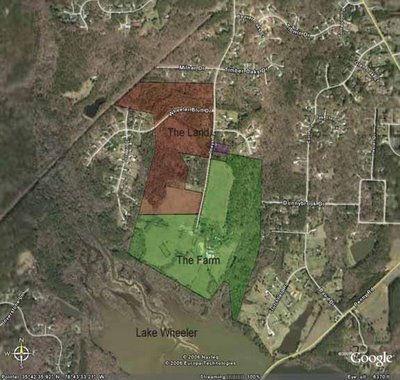Friday, August 18, 2006
We've Got to Get Ourselves Back to the Garden: 11
There was some exciting news, too. NC State is considering using our project in possibly two of their classes this spring. It still has to come up for a vote, but the idea passed the preliminary committee. That means we would have landscape architecture students putting their fertile (ahem--that's a landscape joke) young imaginations to work for the farm. I'm hoping it passes the final vote because I think we would get some wonderful ideas from the students, and it would be nice to have NC State, the alma mater of John and his sister Jackie, involved.
On Saturday evening, we stopped in Bristow, VA, which is not very far outside Washington, DC. We had four tickets to see Crosby, Stills, Nash and Young in concert. It was their Freedom of Speech tour. The night was beautiful--about 70 degrees (F) and a near full moon. The outdoor arena was just about full of nearly 13,000 enthusiastic people and our seats were mighty good. It was a wonderful concert. And they ended with "Woodstock" in that lovely, haunting harmony--
We are stardust,
We are golden,
We are billion-year-old carbon,
And we've got to get ourselves back to the garden.
Thursday, August 10, 2006
Back on the Farm: 10
John was reminiscing with his mother this morning--where else but in the kitchen--and they began to speculate about the ways the old roads used to run through the farm before the bottom land was flooded for the reservoir. There used to be four piles of stone that marked the corners of a large rectangle and a deep circular hole nearby. John used to go there as a child, and always thought that it was an old house and its well so he assumed that the road must have run that way. But Mom said no. That was an old slave house. I guess there's no reason to think there was a road there at all, since I don't imagine there was much of an interest in putting roads to slave houses in the bad old days. I've always known that there was a slave graveyard somewhere on the farm, but the idea of the house makes it all more real. Mom says this house was the overseer's house and that the plantation owner lived in town, in Raleigh. It's hard to truly imagine it all.
Tomorrow is our last day here before we head home to Connecticut. Of ocurse, we didn't do anywhere near as much as we would have liked as far as making progress on the FarmFront project. But there is the reality of being here and seeing (and hearing and smelling) it all again, and that's important too. From the youngest family member--one-year old Elahna--to the oldest--Dad, who will be 87 in September--we got to see just about everyone who still lives nearby. And if all goes well, future generations will be able to reconnect here for many years into the future.
Thursday, August 03, 2006
Old Friends: 9
Last week, John got a surprise email from an old friend, Deborah. She and John go way back to those crazy-friendship days you have in your early 20s. You know, the kinds of friendships you make in college and graduate school when anything is possible, and everything is new--and usually hilarious. It's all about sharing horrible dinners you cook yourself in some pan you found in the neighbor's trash, helping each other build bookshelves out of cinderblocks and old boards, and, well, other things that I just won't get into right now. But John and Deborah were friends in the city when John was at NYU and I've heard a lot about this group of pals over the years. I even met Deborah once a long time ago. John and Deborah have stayed in touch on the once-every-few-years level, and this email was just a hey-how-ya-doin' kind of thing.
John decided to answer with the news about FarmFront, and to his great surprise, got a most enthusiastic reply from Deborah. It seems that she's interested in sustainable living too, and even owns some land about an hour away from the farm, so now they're talking. She knows about straw bale houses, log end houses, and solar houses (hmmm--there's a bit of a Three Little Pigs thing going on there, if you think about it) and seems to spend a lot of her time growing things. We're hoping to get to see her while we're in North Carolina. By the way, she mentioned a story about an "attack goose" on the farm that is going to require some looking into.
I'm a huge Paul Simon fan, and always liked the Simon and Garfunkel song, Old Friends. At 16, I was completely overwhelmed by the touching image of two really, really old ("...how terribly strange to be 70...") people, sitting next to each other on that park bench, useless "bookends" living on borrowed time. Seventy! Hey, seventy is the new 40. So now I see it a little differently. Maybe 70 will be a time we spend in our state-of-the-art, sustainable house, keeping in shape with a little work outdoors, and book-ended by lots of people just like us--and who knows? Maybe even by some old friends.
Tuesday, July 25, 2006
An Inconvenient Truth : 8
Last night, we went to see An Inconvenient Truth. (That's Al Gore's documentary about global warming.) It isn't often that a movie has me in its thrall to the degree this one did without Marlon Brando, or at least a great cinematographer. This movie had neither. But, it was never dull, never boring and just about always chilling.
I was a little reluctant to see it, because I was afraid it would leave me discouraged--that it would feel hopeless, just at a time when it feels like we may have an oportunity to do something--something small, but something--about the way we live. But, that didn't happen. I came away with perhaps a little more hope than before that we'll all manage to get our act together and do something before it's truly too late.
This flick thoroughly debunks the ridiculous idea that Global Warming is "just a theory" with as many scientists lined up for it as against it. Of course, as I'm fond of saying, the idea that the sun will rise tomorrow is "just a theory" too, but it directly addresses the scientific opinion in peer reviewed journals, where the opinion is just about unanimous. Anyone can say he or she is a scientist, but in peer reviewed journals is where you'll find the genuine scientists.
At one point, Gore put up a chart showing how small actions taken by enough people can make the difference in getting us back to the CO2 levels of 1970. Okay, I have to admit it was more a symbolic than quantitative chart, but it got the idea across. Better to do something than nothing. Here is a link to the site.
I suppose this entry is only indirectly about our plan, but there is a relationship. Green living os one answer. Actually, it's the only answer for an individual. We might not be able, as individuals, to change corporate policies directly, but if we stop looking like we want the energy squandering products and lifetstyles we're constantly offered, maybe corporate America will stop offering.
Tuesday, July 18, 2006
Of Ponies, Presents and Perennials: 7
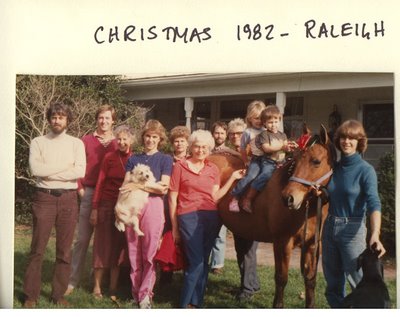 My friend Eileen pined for a pony, but I never did. Practical even as a child, I always wondered what she could possibly do with it on our Brooklyn street. I wasn't into that whole pony thing; I wanted a houseboat. But still, it was pretty exciting when my niece Sherrie got a pony on Christmas Day, 1982.
My friend Eileen pined for a pony, but I never did. Practical even as a child, I always wondered what she could possibly do with it on our Brooklyn street. I wasn't into that whole pony thing; I wanted a houseboat. But still, it was pretty exciting when my niece Sherrie got a pony on Christmas Day, 1982. Thursday, July 13, 2006
Back on Tuesday
Wednesday, July 12, 2006
A Logo for the Website: 6

We continue to chip away at our plan. Right now, most of what we are doing consists of talking to people and reading, reading, reading. But we are working on making our website, FarmFront.com, more real. One of the things we wanted was a logo. We had some leftover drawings from years ago, when we were creating a logo for our consulting business. That company's name is Copper Beech Development, although it has nothing to do with land development. It began life as a software development company, and we thought some of the logo mock-ups presented to us had too strong a whiff of land development to them. But, we really liked one of them and I kept it.
After a whole lot of searching, I actually managed to find it. The envelope it was in was kind of yellow and ratty, and the illustration board had an interesting little warp to it. But simply finding it was something of a miracle. I have to confess that I save just about everything, but I never can find anything when I want to use it. Our son Colin, who is 21, worked on a scanned version of the mock-up. He made a few changes, jazzed it up a bit, added the name "FarmFront" and now we're using it. You can see it right up there on the top left. The website is coming along bit by bit. Much is still missing
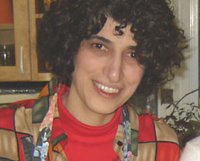 and we keep changing our minds about what should be on there and where, much to Colin's dismay. Did I mention he's doing the site, too?
and we keep changing our minds about what should be on there and where, much to Colin's dismay. Did I mention he's doing the site, too?I've always liked the logo because I thought it was just plain pretty. Now, I see in it both Mother Nature's trees and a family tree. Perhaps I'll hug it, and give it even more meaning. ;)
Monday, July 10, 2006
Organic Farming: A Way to Support the Farm? 5
So, we've started to look into how this is done. Of course, we're being careful because we want to avoid fake organics, of the type that American mega-business would like to substitute for the real thing. This is another iceberg whose tip we're just beginning to see, but there's a lot of encouraging material out there. Here's an example of a success story in organic farming. The Rodale Institute has been active in this area for a long time and is a nice resource if you've got an interest.
www.rodaleinstitute.org
Saturday, July 08, 2006
Everyone's Going Green, It Seems: 4
We began by mentioning it to a few friends at home. The reaction was almost universally enthusiastic. Bit by bit, step by step, we've begun the process of networking ourselves into the bigger world of green development, and we are heartened and pleased by how well the idea has been received. We've begun to learn about the meaning of LEED-compliant development, triple-bottom line, zero energy building, net metering and a whole host of ideas that various contacts along the way have introduced us to. And once you learn about one of these ideas, it seems you begin to see it everywhere. Which reminds me of something that happened years ago. John and I lived in a little rented house on the beach and we decided we would start a salt water aquarium using animals from Long Island Sound. We poked around the beach quite a bit and never found any hermit crabs, but we figured we'd manage without. The first step was to gather gravel from the beach. We came home with two buckets of gravel, only to find that the pebbles and stones were in fact about a third hermit crabs. And after that? We saw hermit crabs all over the place every time we walked the beach. Well, it's like that with green building. I'm delighted to report people are thinking about it--and doing it--everywhere. Just last night, on the way out to dinner, we saw a school under construction, with a sign that read "Largest Solar Project in the State" and that was right in our own backyard! Cool!
Friday, July 07, 2006
A Bit About the Farm: 3
When I first heard John talking about the farm, I envisioned something out of the Wizard of Oz. You know, dry and lots of people in overalls. When I saw the place, I realized I wasn't in Kansas, at least not a la MGM Studios. It was lush, green and both busy and sleepy at the same time. There were people coming in and out, constant small emergencies to be dealt with, and always some animal that needed feeding. But there was also a strong sense of time standing still, of a place removed from other places, where between emergencies and door-slams and feedings, you owed no obligation or explanation to anyone. Of course, by that point, the farm was no longer functioning as intensely as it had in its earlier years. I came to learn there had been much less of the sleepy part back then. But, I saw right away that my husband's childhood and mine had probably more than a little different.
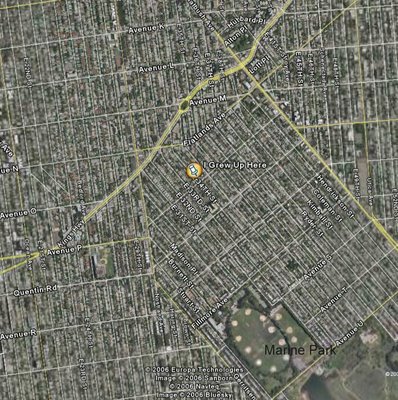 My old neighborhood in Brooklyn, NY. At the bottom right of the picture, you can see part of Marine Park. The visible portion is just about the size of the entire farm. QUite a few of my 100-kid blocks would fit in that space!
My old neighborhood in Brooklyn, NY. At the bottom right of the picture, you can see part of Marine Park. The visible portion is just about the size of the entire farm. QUite a few of my 100-kid blocks would fit in that space!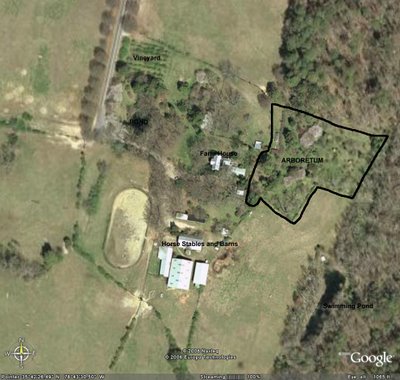 The center of the farm today. You can see the stables and the horse ring. The arboretum contains many trees and shrubs from around the world that my father-in-law planted and tended. You can also see some of the trees they planted along the road. They bloom in the spring.
The center of the farm today. You can see the stables and the horse ring. The arboretum contains many trees and shrubs from around the world that my father-in-law planted and tended. You can also see some of the trees they planted along the road. They bloom in the spring.The horse farm is run as a co-op right now. Some of the people in the co-op have had their horses there for 20 years. My mother-in-law and father-in-law both loved to garden, and after he retired, they devoted all their free time--when they weren't traveling--to their gardens. One of my outstanding memories is the almost overwhelming jasminey scent of the Osmanthus fragrans on autumn evenings. It's planted right beside the big front porch. My mother-in-law loves birds, and has always kept peacocks, Guinea Hens, various chickens and such roaming the farm. The peacocks roost in the trees at night and it was their unearthly shrieks, that sound just like "Heeeeeeeelp!" to city ears, that woke me in the middle of my first night there and had me clinging to the bedpost. One time, there was even a pet turkey. Her name was Gertie and she thought she was a dog. If you sat outside, she'd come over and cozy right up next to you. The surprising thing is, she could leave you with a numb foot, just like a big dog.
Thursday, July 06, 2006
So Here's the Basic Story: 2
The second part of this tale is about a piece of land--about 60 acres--that Johnnie and Georgia gave to their children as a gift many years ago. This land is adjacent to the farm, and the idea was that someday we would sell it or develop it, but "someday" was always so far in the future, that no one ever felt much need to think about it very much. This picture shows the farm and the land, which we all call "The Perdue Property" after the family who sold it years ago. Incidentally, the accent in Perdue is on the first syllable, in good old southern style.In March of this year, we took our daughter for an overnight trip to visit colleges. In the car, somewhere near Vermont, my husband returned to a favorite conversation of ours--how much we'd like to build an energy-efficient house. We've been talking about this on and off since the late 70s, but that day it suddenly struck me. "Why couldn't we build green houses in North Carolina?" I said. We all had the same thought, which can be summed up as "Oooooooooh"! We called my son at college. His reaction can also be summed up as "Oooooooooh"! But then it was time to get out of the car and look at a college.
Later that night, John had the inspiration that made this idea so special. "We could give the community access to the farm, " he said. Within moments, the synergy was obvious. It was a delightful answer to a problem that had been perplexing all of us for years: what would happen to the farm when it came into the hands of the next generation? How could we afford to keep it? What would we do on it? Who would live there? No one had been able to answer those questions, and so we had--with a lot of sadness--concluded that the farm would have to be sold. And even though it could not be developed or divided, it seemed destined to become the playground of one wealthy family. Suddenly, we could see a glimmer of hope, not only for keeping the farm, but for keeping it alive, the way Georgia and Johnnie had always envisioned.
Wednesday, July 05, 2006
The Theys Family Farm: 1
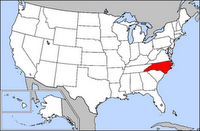 uture in-laws, but as the first time I set foot on that very special place—the Theys family farm in Raleigh, North Carolina. On the map, that's North Carolina in red; Raleigh is just about in the center.
uture in-laws, but as the first time I set foot on that very special place—the Theys family farm in Raleigh, North Carolina. On the map, that's North Carolina in red; Raleigh is just about in the center.A lot has changed over the years, and like many families, we know the day will come when we can no longer afford to hang onto the farm, but we don’t want to let it go either. So, we have a plan, or at least the beginnings of a plan. We'd like to build a small community of sustainable housing adjacent to the farm, and to incorporate within that community access to the farm and all it has to offer. We envision a community of homes whose owners share a common interest in green, sustainable living, and a love of the vanishing American family farm. We’re calling this “farm-front property.” Just like ocean front and lake front property, American farmland is not only limited, it’s disappearing fast. But our farm is guaranteed to be preserved, as I will explain in later posts. We have just begun, and this blog will record our progress as we continue, and hopefully succeed. There’s a lot to tell, and I hope to post every day, recording not only our progress, but some of the history of the farm and the family.
